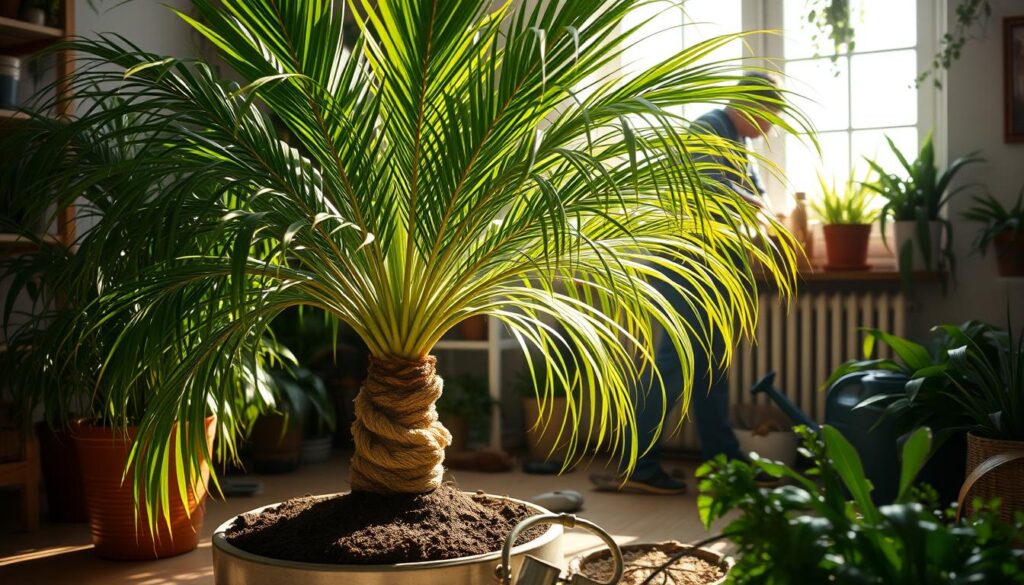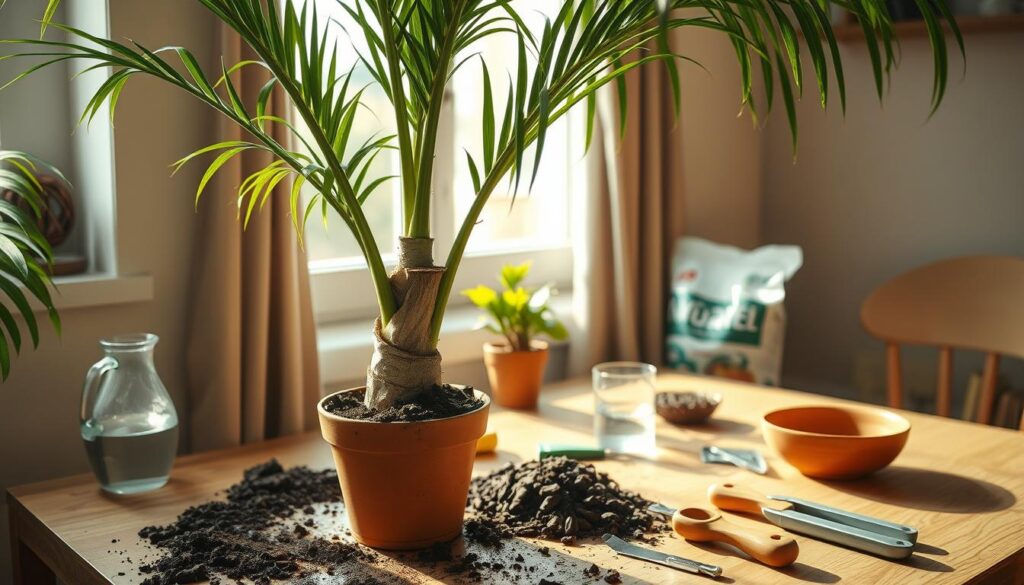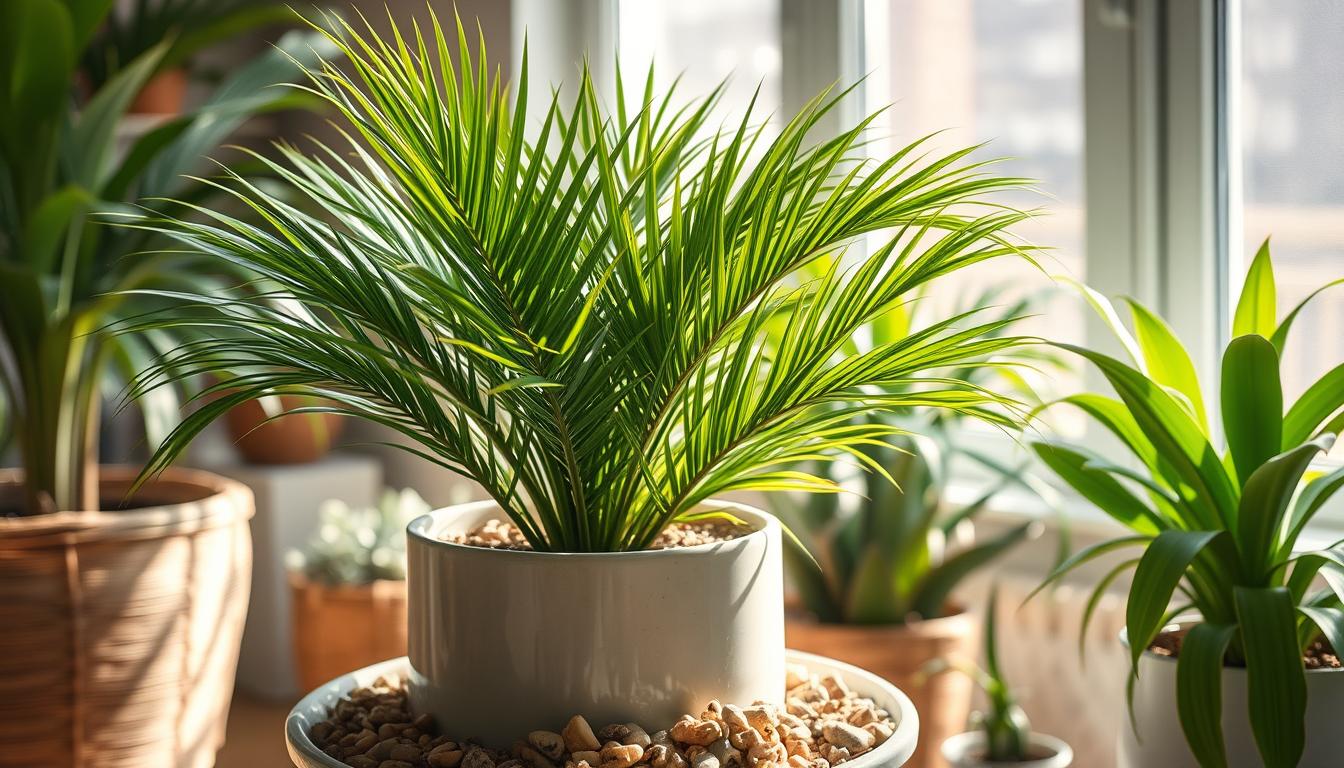What makes Ponytail Palm care special? How can you make sure your plant does well indoors? Caring for Ponytail Palm means paying attention to its needs, like watering and fertilizing.
With the right care, you’ll get to enjoy its benefits. These include cleaning the air and looking great in your home.
Learning about Ponytail Palm care is exciting. You’ll find out how to create the best home for your plant. This includes knowing the perfect temperature and avoiding problems like root rot.
By following the right steps, you’ll get to enjoy your Ponytail Palm. It’s a beautiful and easy-to-care-for houseplant.
What is a Ponytail Palm?
The Ponytail Palm is a special plant from the agave family. It’s called Beaucarnea recurvata and comes from Mexico. It can grow up to 30 feet tall outside, but stays smaller indoors.
Its Ponytail Palm characteristics include a big bulbous trunk. This trunk can be up to 12 feet wide. The leaves are long, up to 6 feet, and thin, about 1 inch wide. They hang down, making the plant look unique.
Some key features of the Ponytail Palm include:
- Ability to survive extended droughts due to its water-storing trunk
- Production of large, upright branched panicles with numerous flowers that are attractive to bees
- Dioecious nature, meaning only female plants produce seeds
The Ponytail Palm is easy to care for and lives a long time. It does well in many places, making it perfect for indoor gardens.
Benefits of Having a Ponytail Palm
The Ponytail Palm is a special and pretty plant. It’s great for any indoor spot. It helps clean the air, making it better to breathe. NASA says it’s one of the best plants for this.
It also looks good, with a big base and long leaves. This makes it perfect for homes or offices. Some good things about having a Ponytail Palm are:
- It makes the air cleaner
- It looks nice, adding beauty to any room
- It’s easy to care for, needing little water and food
- It can grow well in different light levels
So, the Ponytail Palm is a smart pick for indoor plants. It’s pretty and helps clean the air. It’s a great choice for any home or office.
| Benefit | Description |
|---|---|
| Air Purification | Removes harmful toxins like xylene, toluene, and benzene from the air |
| Aesthetically Pleasing | Unique appearance, with a bulbous base and long, slender leaves |
| Low Maintenance | Can survive in low-fertile soil and with infrequent watering |
Ponytail Palm Care Basics
To keep your Ponytail Palm happy, you need to know the basics. Lighting is key for this plant. It likes bright, indirect light, perfect for rooms with west- or south-facing windows. This helps it grow and photosynthesize.
Soil is also important for your Ponytail Palm. It needs well-draining soil to avoid root rot. Use a cactus or succulent mix to keep the soil right. With good care and lighting, your plant will thrive.
Here are some important care tips:
- Watering: Water every 7-14 days in the growing season, and once a month in winter.
- Temperature: Keep it between 65-85°F (18-30°C).
- Humidity: It can handle low humidity but prefers a humid environment.
Follow these tips to keep your Ponytail Palm healthy. Watch your plant and adjust care as needed. With the right care and lighting, you’ll enjoy this unique plant for years.
| Ponytail Palm Care Tip | Description |
|---|---|
| Lighting | Bright, indirect light |
| Watering | Every 7-14 days during growing season, once a month during winter |
| Temperature | 65-85°F (18-30°C) |
Watering Your Ponytail Palm
Watering your Ponytail Palm is key. It stores water in its trunk, so it can get too wet. Water it just enough, letting the soil dry out before you water again. This keeps the roots healthy.
To know how much water your Ponytail Palm needs, look at a few things:
- Soil moisture: Stick your finger into the soil up to the first knuckle. If it’s dry, it’s time to water.
- Environmental conditions: Indoor Ponytail Palms need water every 3 to 4 weeks. This depends on the temperature, humidity, and light.
- Signs of thirst: If the leaves start to droop, your plant needs water. Check it often and water when needed.
By following these tips, you can give your Ponytail Palm the right amount of water. It’s safer to water a bit less than too much. This way, you can fix it if it’s too dry.
| Watering Frequency | Soil Moisture | Environmental Conditions |
|---|---|---|
| Every 3-4 weeks | Dry to the touch | Indoor, average temperature and humidity |
| Every 1-2 weeks | Moist but not waterlogged | Outdoor, high temperature and humidity |
Knowing how much water your Ponytail Palm needs helps it stay happy. Watch how it reacts to watering and change your schedule as needed. This way, you’ll keep your plant in top shape.
Temperature and Humidity Needs
Creating the right home for your Ponytail Palm is key. It likes temperatures between 65-75°F, which is common indoors. It also does well in average humidity, but more can help it stay healthy.
To keep the right humidity, you can use a humidifier. Or group plants together to make a cozy spot. Make sure your Ponytail Palm is not near cold drafts or air vents. For more tips, check out indoor care tips for palm plants.
Important things to remember about your Ponytail Palm’s needs are:
* It likes temperatures between 65-75°F.
* It prefers humidity levels of 50% – 60%.
* More humidity helps it stay healthy and prevents leaf rolling.
* Keep it away from cold drafts and air vents.
By meeting your Ponytail Palm’s needs, it will thrive in your home. Remember to watch how your plant reacts to its environment and change its care if needed.
Fertilizing Your Ponytail Palm
To help your Ponytail Palm grow well, fertilizing is key. Use a balanced, water-soluble fertilizer in spring and summer. This gives your plant the nutrients it needs.
For the best fertilizer, pick a water-soluble one made for succulents. Jack’s Classic Blossom Booster is good, with a 10-30-20 N-P-K ratio. Slow-release fertilizers like 13-13-13 and 14-14-14 also work well.

To fertilize, mix the fertilizer half as strong as the label says. This prevents harming the roots. Fertilize every 1-2 weeks in spring and summer. In winter, do it once a month. Always follow the instructions to avoid harming your plant.
Best Practices for Fertilization
- Fertilize during the growing season (spring and summer) for optimal results.
- Use a balanced, water-soluble Ponytail Palm fertilizer specifically designed for succulents.
- Dilute the fertilizer to half the recommended strength to avoid burning the roots.
- Follow the fertilizer packaging instructions to avoid over-fertilization.
By following these tips and using the right fertilizer, your Ponytail Palm will grow well. Remember to fertilize in the growing season and follow the instructions for the best results.
Common Pests and Diseases
As a Ponytail Palm owner, you need to know about pests and diseases. Pests like mealybugs and scale can harm your plant. Diseases like root rot can happen if you water too much. It’s key to check your plant often.
Look for white, cottony patches on leaves or stems for mealybugs. Scale insects look like waxy bumps. If you see these signs, act fast to stop pests and diseases.
To fight pests, mix isopropyl alcohol and water, or use insecticidal soap. Keep your hands clean before touching your plant. Don’t overwater, as it attracts pests. These steps help keep your plant safe.
Here are more ways to stop pests:
- Use a potting mix that drains well to avoid soggy soil
- Water carefully, avoiding leaves and crown
- Make sure air moves well around your plant
- Watch your plant for pests or diseases often
By following these tips, your Ponytail Palm will stay healthy and look great. Enjoy its beauty for many years.
Pruning and Maintenance Tips
As a Ponytail Palm owner, you want your plant to stay healthy and strong. Ponytail Palm pruning is key to keeping it looking good and growing well. Prune in spring or summer when it’s growing fast.
For Ponytail Palm maintenance, take off dead or damaged leaves to stop disease. Check out trusted houseplant guides for more care tips. Here are some important ones to remember:
- Use clean, sharp tools to make cuts just above a node.
- Do not remove more than 20% of the plant’s foliage at a time.
- Water minimally after pruning to prevent root rot.
By following these tips, your Ponytail Palm will stay healthy and strong. Prune and maintain it often to help it grow and thrive.
| Pruning Tips | Benefits |
|---|---|
| Remove dead or damaged leaves | Prevents the spread of disease |
| Use clean, sharp tools | Helps the plant heal quickly |
| Do not remove more than 20% of foliage | Prevents shock to the plant |
Repotting Your Ponytail Palm
Your Ponytail Palm will grow and need a bigger home. You should repot it every 2-3 years. Pick a pot that’s just a bit bigger than the old one. Use a mix that drains well to keep the soil dry.
Some important things to remember when repotting your Ponytail Palm include:
- Choose a container that is 1-2 sizes larger than the current one
- Use a well-draining potting mix to prevent waterlogged soil
- Handle the roots with care to avoid damaging them
After repotting, let the plant dry for a week before watering well. This helps the roots settle and avoids root rot. With the right care, your Ponytail Palm will do great in its new home.

By following these easy steps, you can repot your Ponytail Palm successfully. This will give it the space it needs to grow and thrive.
| Container Size | Repotting Frequency |
|---|---|
| 6-8 inches | Every 2-3 years |
| 10-12 inches | Every 3-4 years |
Propagation Techniques
There are many ways to grow Ponytail Palms. You can use offsets, division, or seeds. Offsets are the easiest and work best.
To grow from offsets, take them off the main plant and plant them in a pot. This method is simple and works well. Division is also an option but needs more care. Seeds are the hardest but can be fun for experts.
Here are some tips for growing Ponytail Palms:
- Use cactus soil to avoid soggy soil.
- Keep the soil a bit wet but not too much in the first weeks.
- Give your plant bright, indirect light for at least 6 hours a day.
- Water only when the top soil feels dry.
Follow these tips and pick the right method for your Ponytail Palm. This way, you can share this special plant with others. Make sure to pick healthy offsets for the best results.
With the right care, your new Ponytail Palm will grow well. It will make any room beautiful.
| Propagation Method | Description |
|---|---|
| Ponytail Palm offsets | Easiest and most effective method, with a high success rate. |
| Division | Requires more care and attention, but can be successful. |
| Seeds | Most challenging method, but can be rewarding for experienced growers. |
Troubleshooting Common Problems
As a Ponytail Palm owner, you might face some common issues. Ponytail Palm problems can stem from overwatering, underwatering, or not enough light. It’s key to find the cause and fix it.
Look out for yellow leaves, slow growth, and brown tips. These signs often mean you’re watering too much, the air is too dry, or it’s too hot. Try changing how often you water, giving it more light, or improving air flow.
Yellow Leaves: Causes and Solutions
Yellow leaves can mean you’re watering too much. This can rot the roots and harm the plant. Let the soil dry out between waterings. Also, fertilize with a balanced fertilizer to help it grow.
Slow Growth: What to Do
Slow growth might be due to not enough light, bad watering, or missing nutrients. Give it more light, water it right, or fertilize it. Repotting in a good soil mix can also help the roots grow.
By following these tips, you can keep your Ponytail Palm healthy. Always check on your plant and fix problems quickly.
- Check the soil moisture often to avoid too much water
- Give it bright, indirect light for healthy growth
- Make sure air flows well to prevent pests
- Fertilize with a balanced fertilizer for growth
By following these tips, you can keep your Ponytail Palm happy and healthy. Always watch for problems and fix them fast.
Creating a Stylish Display for Your Ponytail Palm
The Ponytail Palm (Beaucarnea recurvata) is a beautiful indoor plant. It can make any room look better. Pick a pot that looks good with the plant’s shape. You can choose from sleek modern or rustic clay pots.
Put your Ponytail Palm in a place where it can be seen. A side table or floor stand is perfect. It will be a beautiful thing that catches everyone’s eye.
Choosing the Right Pot
The pot for your Ponytail Palm should drain well and look good. Look for ceramic, terracotta, or metal pots. They will make your display stylish.
The pot should be big enough for the plant to grow. It needs room for its thick trunk and leaves to spread out.
Placement Ideas for Maximum Impact
Where you put your Ponytail Palm matters a lot. In small spaces, one big pot can be enough. It will show off the plant’s shape well.
In bigger rooms, you can put several Ponytail Palms together. They will look like a mini-forest. This is also great for using space up on walls.
If you want to see other awesome statement plants for your indoor garden, check out our article on 10 statement plants to add to your indoor garden.





Pingback: The Ultimate Guide to Houseplants: 100 Best Indoor Plants for Every Home - Trusted House Plant Guide